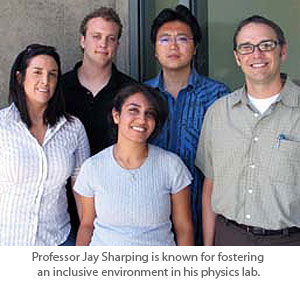

When you visit
Professor Jay Sharping’s lab Web site,you might notice something unusual.
For now, he doesn’t advertise open positions. Instead, he invites each prospective team member to submit qualifications and a description of the desired position.
It can be a little uncomfortable not to have total control of everything, he said. But I prefer that each person has an interesting, rewarding experience - that’s more important than steering everything myself.
This approach has created a diverse, cooperative group of four students in his applied photonics lab this summer.
Sharping, a professor of physics in the UC Merced
School of Natural Sciences, says they fit together well.
First to arrive was Jeremy Sanborn, a junior physics major from Livermore, two years ago. He presented his results from fiber tapering experiments at the CLEO physics conference in San Jose in May and expects to publish later this year. He’s starting a new project examining two-photon absorption using pulse lasers.
I see basic concepts from my classes elevated and expanded in the lab, Sanborn said. And I recognize things from the lab when I learn about them on a more basic level in class.
Last year, two graduate students joined Sanborn. Tessa Piñon came from El Paso, Texas, and Chenji Gu traveled from his hometown near Shanghai, China, to study with Sharping.
Piñon is already successful with her project trapping objects - microbeads and even mouse embryonic stem cells - between two lasers. She collaborates with bioengineering Professor Michelle Khine, who specializes in instrumentation for biological applications.
It helps to see the intertwining of the two worlds of bioengineering and optical physics, Piñon said.
UC Merced’s interdisciplinary philosophy helps Gu, too. In China, he studied electrical engineering. He wanted to move toward basic research in physics, but most physics graduate programs shy away from students with engineering backgrounds.
Sharping saw strengths and skills in Gu that have already begun to contribute to the research group. Gu is working on a measurement system to characterize ultra-short optical pulses. He collaborates with
Professor Boaz Ilan, an applied mathematician at UC Merced, on the theoretical aspects of this work.
This summer, the team has a new addition -senior physics major Leily Kiani from Napa Valley. A participant in the Alliance for Graduate Education and the Professoriate (AGEP) program, she’s modeling a previously conducted experiment on optical parametric amplification. After only a week, Sharping said, Kiani has made great progress understanding her complicated, multilayered task.
The team collaborates without worrying much about disciplinary boundaries or academic hierarchy - a cultural marker of the UC Merced research experience. Piñon gladly points out that Sanborn helps her a lot, even though she’s a Ph.D. student and he’s an undergraduate.
Chalk it up to Sharping’s inclusive attitude - from which all the students seem to benefit.
Every week it’s a new adventure, Sanborn said. You can’t know what to expect, but I’ve found there’s a sense of accomplishment at the end of each day, and I want that.






